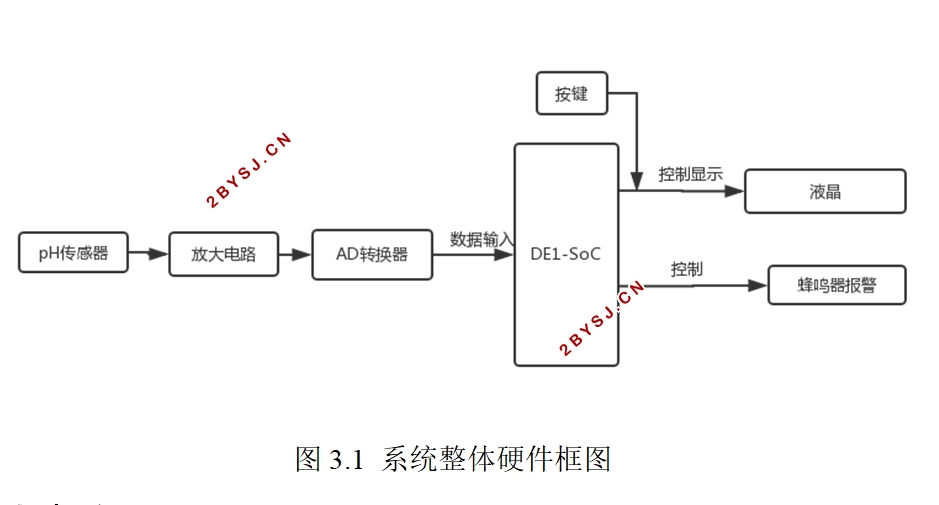基于FPGA的液体pH值测量电路的设计
无需注册登录,支付后按照提示操作即可获取该资料.
基于FPGA的液体pH值测量电路的设计(任务书,开题报告,外文翻译,论文13600字)
摘要
本论文设计利用电化学原理和FPGA技术对溶液中的氢离子浓度进行测定。论文具体地说明了基于FPGA的pH测量系统的设计,囊括pH电极的原理、系统硬件设计、系统软件设计以及后期电路调试。
pH测量电路利用原电池原理,使用将指示电极和参比电极复合在一起的pH玻璃电极,将化学信号转换成电信号,一般为0~200mV。利用放大电路放大这一微弱的电信号(放大倍数为3倍)后传输给AD转换器。AD转换器将转换结果传输给FPGA。FPGA计算出当前溶液的pH值(0~14)后再利用FPGA来控制液晶显示屏显示出实时液体pH值(精确到小数点后一位)。另外,无需另外接线,利用FPGA的可编程能力以及实验箱(DE1-SoC)自带的硬件还可给系统增加蜂鸣器报警(当pH值不在设定范围时蜂鸣器发声)以及pH范围按键控制(以六个按键控制pH范围上下限的十位个位和十分位,按键按下时相应位数值加一)并显示等功能。本设计最终利用了FPGA易于编程这一特点来实现溶液pH智能测量及显示,创新地用FPGA与pH测量相结合,成功实现了基于FPGA的液体pH值测量系统。
关键词:pH电极;FPGA;AD转换器;液晶显示
Abstract
In this paper,the concentration of hydrogen ions in solution was determined by electrochemical principle and the FPGA technology.This paper described the design of pH measurement system based on FPGA in detail,including the principle of pH electrode,system hardware design,system software design and problems of later circuit debugging.
The pH measurement circuit uses the principle of the original battery system.It uses the pH glass electrode which combines the indicating electrode and reference electrode to convert the chemical signal into the electrical signal.The week signal was amplifies by the amplifier by ten times before it is transmitted to the AD converter.And then the AD converter transmits the conversion results to the FPGA.Next,it calculates the pH value(0~14) of the current solution and control the LCD display to show the value. In addition,the powerful programmable ability of FPGA and the hardware of the test box(DE1-SoC) add functions such as buzzer alarm and pH range control to the system without additional wiring.As FPGA can easily be programmed,the design combines FPGA with pH measurement and successfully realizes the measurement system of liquid pH value based on FPGA.
Key Words: pH electrode;FPGA;AD converter;LCD display


目录
第1章绪论 1
1.1 背景介绍 1
1.2 pH测量系统研究的重要性 1
1.3 pH传感器的种类及发展状况 1
1.3.1 8-羟基喹啉-5-磺酸修饰电极pH传感器 2
1.3.2 聚苯胺修饰电路超微pH传感器 2
1.3.3 光化学pH传感器 2
1.3.4 固态pH传感器 2
1.4 pH测量及显示系统的主要原理 2
1.5 pH测量系统的发展状况 3
1.6各章简介 4
第2章 pH传感器原理 5
2.1方法简介 5
2.2 pH玻璃电极的构造 5
2.3 pH玻璃电极响应机理 6
2.4 玻璃膜电极电位的产生及测量原理 6
第3章硬件描述 8
3.1整体框图 8
3.2 放大电路 8
3.2.1 放大原理 8
3.2.2 使用芯片 9
3.2.3 LM385-2.5 10
3.2.4放大电路 11
3.3 AD转换器 12
3.3.1 ADC0809的逻辑结构 12
3.3.2 ADC0809的主要性能指标 13
3.3.3 ADC0809的内部逻辑结构 14
3.3.4 ADC0809的时序 14
3.3.5 接口电路 15
3.4 LCD1602液晶显示屏 16
3.4.1简介 16
3.4.2 LCD1602特性 17
3.4.3 引脚 17
3.4.4 LCD1602显示原理 18
3.4.5 LCD1602的指令说明已经时序 19
3.4.6 LCD1602中的CGROM、CGRAM和DDRAM 20
3.4.7 LCD1602的时序 21
3.4.8 LCD1602时序参数 22
3.5 蜂鸣器 23
第4章软件设计 24
4.1 软件 24
4.1.1 软件简介 24
4.1.2 软件功能 24
4.1.3 软件界面图 24
4.2 使用的语言 25
4.2.1 VHDL简介 25
4.2.2 VHDL语言的基本程序结构 25
4.3系统软件设计 26
4.3.1主要框架 26
4.3.2 数据处理 27
4.3.3 AD转换器控制 28
4.3.4 液晶控制 29
4.3.5 按键控制 31
4.3.6 报警控制 31
第5章 实物调试 34
5.1实物调试及解决方案 34
5.2误差分析 34
第6章结论与展望 35
6.1 结论 35
6.2 展望 35
参考文献 36
附录A 37
致谢 46
